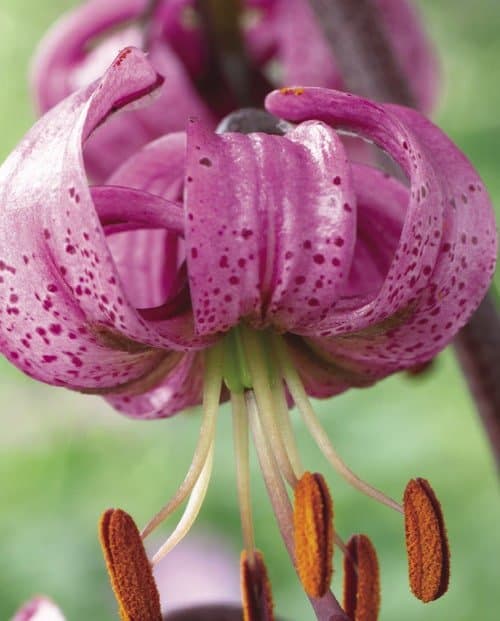
I nearly drove off the road when I passed a neighbour’s garden this week and spied something tall and dangly. It was a cluster of four-foot (1.2-m) stems bearing speckled, pink downward-facing Martagon lilies (Lilium martagon). The flowers resemble butterflies in flight and are good enough to fool the local red admirals that pay them some attention. I’ve never seen a lily I didn’t like, but these are something special. Their irresistible appeal is a combination of unlikely architecture (those tall skinny stems), charmingly speckled petals and the swaying, bobbing movements that beckon to passersby.
Martagon lilies are just one in a group of species lilies that can be grown in northern gardens (generally hardy to Zone 4) and, best of all, prefer the alkaline clay loam of my garden. Their tall stems climb ever upward, sometimes reaching five to six feet (1.5 to 1.8 m), and begin to flower in midsummer, blooming for about three weeks. They don’t mind slightly heavy soil if it drains well, asking only to be left alone and undisturbed. They dislike peat moss, because it holds too much moisture around the bulbs, but they do appreciate a mulch of leaf mould or shredded fresh leaves. Their small bulbs are best planted in fall (what lucky timing this is!) and sometimes sulk for the first season, not showing themselves until the second year. But thereafter, species lilies put on increasingly strong shows if allowed to remain undisturbed.
The first species I grew was the leopard, or panther, lily (L. pardalinum), an impressive six-foot (1.8-m) stem carrying intensely orange flowers with dark brown speckles and flaring anthers. It lived in the garden for a decade, then was jumbled about and lost during a tree removal. I also grew L. citronella (46 inches/117 cm), a cheery yellow flower with chocolate-brown spotted petals. These related species have reflexed petals with flaring filaments and shameless pollen-bearing pistils, and many have a sprinkling of dark brown spots. Some, like bright orange L. henryi (60 inches/1.5 m), have strange glandular-like formations on the petal ribs (like the scent glands lining moss roses). The shorter 24-inch (60-cm) L. tenuifolium has silky red unmarked petals.
I had a good look at my neighbour’s Martagon lilies, checking for any suspicious insect damage on foliage, stems and flowers, and all parts appeared to be in good health and working order. My own bulbous lilies (and every kind of fritillaria) were devastated some years ago by red lily beetles. Unable to defeat or control the voracious red tide, I just stopped planting replacement lilies and lived on memories. Now I wonder if perhaps the red lily beetles have declined or met their fate with a natural predator. That was the case with earwigs, which once seemed to be practically breeding in the baseboards, but are now greatly reduced in my garden.
It doesn’t take much to get me hooked, and I’m going to gamble on species lilies again this fall. (I’ve seen some at veseys.com and bdlilies.com.) Fortunately, the bulb catalogues and websites are just gearing up for autumn shipments, and I’ve got my eye on ‘Claude Shride’ (L. ‘Claude Shride’), a hybrid Martagon lily with mahogany-red petals and orange anthers, and ‘Mrs. R. O. Backhouse’ (L. x dalhansonii ‘Mrs. R. O. Backhouse’), with straw yellow petals, soft magenta on the reverse, and a sprinkling of red spots. I’ll try a few of the bright orange L. henryi, too.
Life is always a gamble, and gardening even more so.

I would love to see a feature on Lilies in your magazine. More so I would love to see a repeat feature on garden pests, their identification,life cycles and their iradications both chemical and biological/organic. My garden is 10 years old, and I have not until last year had any trouble with lily beetles. They started last year, and have exponentially multiplied this year, and have devastated all my lilies, fritillia and some other plants accept for my day lilies. I plan on moving soon, I wonder if I lift the bulbs if they will follow me to my new residence!?
From Judith Adam: I understand and share your frustration with the red lily leaf beetles. The adult beetles winter over in soil and emerge in early spring to feed and lay eggs for a new generation. Fritillaria are often their first meal! If you lift your lily bulbs individually and brush clinging dirt away, you won’t be bringing any adult beetles with you in the move (although you might encounter some in the new garden). But if you lift the lily bulbs in clumps, along with their surrounding soil, chances are you might have unwelcome red stowaways. Here is an article with good information about the beetle life cycle, potentially resistant cultivars and some control measures: gardeners.com/how-to/lily-beetle/8090.html. Good luck with your new garden!